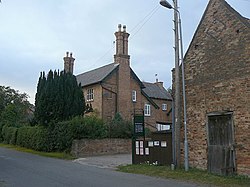Gonalston
| Gonalston | |
| Nottinghamshire | |
|---|---|
 Holme Farm, Gonalston | |
| Location | |
| Grid reference: | SK678475 |
| Location: | 53°1’12"N, 0°59’20"W |
| Data | |
| Post town: | Nottingham |
| Postcode: | NG14 |
| Dialling code: | 0115 |
| Local Government | |
| Council: | Newark and Sherwood |
| Parliamentary constituency: |
Newark |
Gonalston is a small village in Nottinghamshire, just to the north-east of Lowdham and almost upon the A612 trunk road that runs from Nottingham to Southwell.
The parish encompasses some 1,250 acres of arable and pasture land in about equal portions, interspersed with 106 acres of wood and plantations. Beside it runs a small river called the Dover Beck which separates the village from Lowdham and which flows south-east into the River Trent two miles away.
Name
Gonalston seems to contain the Old Norse personal name, Gunnolf' with the Old English tun for a farmstead, village or estate, so 'Gunnolf's farm/settlement'.[1][2]
Parish church
The parish church, St Laurence dates from the 14th century. It stands outside the village centre, in the grounds of the rectory, close to the manor house and home farm.
History
According to Francis White's Directory of Nottinghamshire of 1853, Gonalston:
"is a small rural village and parish, near the Dover Beck, 4 miles south-south-west of Southwell, containing 100 inhabitants and 862 acres of land, enclosed in 1768, when 155 acres were allotted for the tithes. John Francklin Esq. owns the whole lordship, and is patron of the rectory, which is valued in the King's books at £7 19s 2d, now £324, and is enjoyed by the Rev. Edward Walker Foottit B.A. The church, dedicated to St Lawrence, is a small structure, with a tower and two bells, and was rebuilt in 1852. In Thoroton's time it contained some ancient figures of crusaders, but they were either destroyed or removed at the diminution of the church. They have since been taken up by the present proprietor, under the superintendence of Rd. West Macott Esq. R.A., and are about to be placed in the name of the new edifice."[3]
The village was famed in ancient times for its hospital or spital now lost, and its effigies of Crusaders. William de Heris, in the reign of Henry III, founded an hospital here called 'the Spital', "to the honour of St. Mary Magdalene". The successive rectors of the parish were masters, and formerly preached their induction sermon upon its ruins.[4]
Archaeology
Amongst important archaeological discoveries made in the silts of the Trent Valley ae finds from Gonalston. At Holme Dyke, Gonalston, Neolithic pottery has been excavated from a ring ditch, and a Late Bronze Age domestic site (as a burnt mound) was uncovered by quarry workings.
Outside links
| ("Wikimedia Commons" has material about Gonalston) |
References
- ↑ Gover, J. E. B.; Mawer, A. & Stenton, F.M.: 'Place-Names of Nottinghamshire , Part' (English Place-Names Society, 1940), page 166
- ↑ Mills, Anthony David: 'A Dictionary of British Place-Names' (Oxford University Press, 2003) ISBN 978-0-19-852758-9
- ↑ F. White "Directory of Nottinghamshire" (Sheffield, 1853)
- ↑ Godwick – Goodmanham: A Topographical Dictionary of England (1848), pp. 312–315